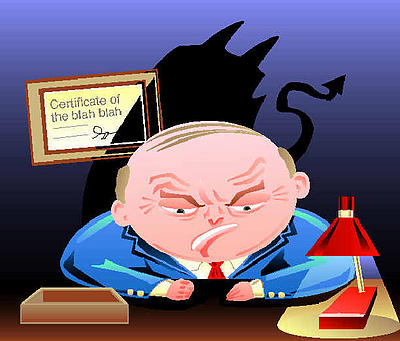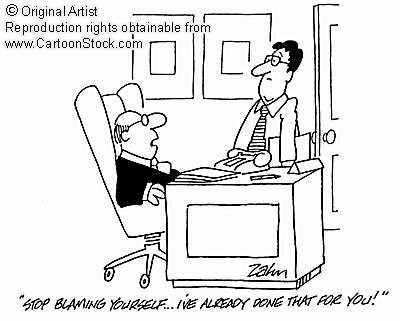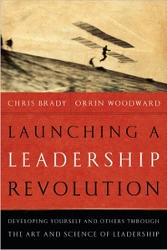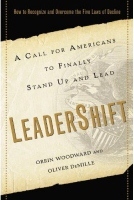Leadership Cultures – Constructive or Destructive Leadership?
Posted by Orrin Woodward on March 1, 2008
I read an enlightening article on the constructive/destructive leadership patterns from Greg Thomas. Greg describes the key differences between an encouraging growth culture and a fear based dictatorial culture. I have worked with both types of cultures and emphatically agree that organizational cultures are created at the top. What type of leader are you? Do you believe in the potential of others or do you need to control, dictate and intimidate them? In my opinion, the command and control organizations are dinosaurs and the talented individuals will run from the fear based cultures to find a growth based culture. Leaders do make the difference. To paraphrase Jim Collins, “Get the right people on the bus—get them in the right seats—then determine what the team’s objective is.” What are your personal experiences with cultures created by both Constructive and Destructive Leaders? Which type of organization brought you the most rewards in your personal and professional life? God Bless, Orrin Woodward
 Many years ago I worked for a division (called a unit) of a Fortune 100 corporation. This large corporation allowed each division to operate independently with their own president and executive team while expecting certain profit and margin accountabilities. The division I worked for had a president named Harry. He was truly a legend in his own mind and believed, as a paternalistic leader, he was beloved by the employees. But virtually all employees I knew despised him and resented his arrogant, authoritarian and demeaning behavior. I was told that Harry was brought into this unit as a “hatchet man” in the 1950’s to reduce bloated overhead, and that he settled in to a 30-year career of tyranny and fear.
Many years ago I worked for a division (called a unit) of a Fortune 100 corporation. This large corporation allowed each division to operate independently with their own president and executive team while expecting certain profit and margin accountabilities. The division I worked for had a president named Harry. He was truly a legend in his own mind and believed, as a paternalistic leader, he was beloved by the employees. But virtually all employees I knew despised him and resented his arrogant, authoritarian and demeaning behavior. I was told that Harry was brought into this unit as a “hatchet man” in the 1950’s to reduce bloated overhead, and that he settled in to a 30-year career of tyranny and fear.
Harry was famous for the many people he abruptly terminated, often out of anger or rage. By the mid 1980’s the corporation decided it was time to terminate him and this was done suddenly on a day when an unannounced corporate executive showed up and told Harry he was fired. The employees could hear shouting through the closed office door and soon Harry stomped out angry and resentful. He later told some friends that it was the way he was terminated that bothered him! He was upset that he wasn’t allowed to say “goodbye” to his friends and co-workers. It struck me as a paradox that Harry didn’t think this was important for the literally hundreds of employees he had terminated during his 30 year reign of terror, yet he felt that he had a “right” to say goodbye. Actually, almost everyone wanted to say “good riddance” to Harry rather than goodbye! Harry exhibited destructive leadership, and the effects on all the stakeholders of the organization were obvious.
This true story of Harry reminds me of an absolute law of leadership. A single leader can’t personally motivate others for very long. A good leader promotes a positive culture that allows others to be motivated and people must use this upbeat atmosphere to motivate themselves. But, on the other hand, a single destructive leader can personally destroy the motivation of others and promote a negative organizational culture.
Allow me to discuss the difference between destructive and constructive leadership. The chart below shows some of the differences. Compare this chart with your organization and see how you measure up.
Type of leadership: Destructive Leadership Constructive Leadership
Type of motivation used: Fear/Force and bribery Empowers and inspires
Vision provided: Short-term focus Long term focus
Result of leadership: Instills passive aggression Instills empowerment
Environment: Creates negative workforce Creates trust and openness
Effects on managers: Managers promote fear Managers promote “win-win”
We will begin by examining destructive leadership. Unfortunately this is by far the most common type of leadership exhibited in the world today. Fortunately, it is slowly beginning to lose ground in the Western world. It is typically centered around a philosophy of control. The destructive leader doesn’t truly believe in the potential of others. In an authoritarian hierarchy, those at the “top” are considered enlightened and important. Those not at the top are considered to be inferior in intelligence and value. Destructive leaders often look upon themselves as the father-like benefactors to the dependent average workers. They view the average employee as childlike, simple and in constant need of strong motivation. The type of motivation used by a destructive leader is usually fear or force. Fear is maintained by making the workers feel disposable if they refuse to conform to the dictates of the leader. Therefore workers must be controlled by an elaborate number of “do’s and don’ts” to force compliance. In this environment workers must also be suddenly terminated as an example to others that it can come at any time or for virtually any reason.
In the company I mentioned at the start of the article, this was the mentality of the destructive leader named Harry. When I joined the organization in the 80’s, males at the headquarters office were not “permitted” to have facial hair, all were expected to wear dark suits and it was forbidden to have a cup of coffee at your desk. Even though there was an elevator to the 2nd floor of the office building, employees were not allowed to use it. Employees were also forbidden to post calendars or pictures on the walls of their small cubical. Harry even designed the office to be wide open with short glass partition walls so he could see what everyone was doing! Only Harry and his executive team had offices with real walls and doors.
Since turnover is high in this kind of environment, bribery is used to keep the best employees. In lieu of a positive working environment and fulfilling work, the destructive leader knows they must bribe the most talented with above average salaries to keep people they need. Promises of exclusive perks and large bonuses are used to control the managers that are considered the most valuable. It is more important to buy their loyalty than risk them pointing out genuine problems or questioning poor decisions. Even a destructive leader knows the organization needs the talents of others to operate effectively and profitably. Therefore they buy off the managers they believe they need in order to mute their independence or a challenge to the leader’s authority. The subliminal message given is, you can make more money and perks here than anywhere else, and if you lose this job you may not be able to make this kind of money again!
 In contrast, the constructive leader deeply believes in the growth and potential of others. Everyone is considered an important part of the team that makes the organization work. Constructive leaders look upon themselves as coaches and mentors. They believe in their people to the degree that they are willing to invest in constant training and the development of a learning organization. They don’t consider others to be workers, employees or children, but valued stakeholders. Those who inspire constructive leadership recognize that everyone has a stake in the growth and success of the company. They nurture the development of a positive culture where others are empowered to make responsible decisions without fear or reprisals. Of course, the organization has strong values and sound policies but these exist to provide order and mutual respect, not to control or limit others. The constructive leader believes in a fair and generous compensation package for everyone and not simply the selected few.
In contrast, the constructive leader deeply believes in the growth and potential of others. Everyone is considered an important part of the team that makes the organization work. Constructive leaders look upon themselves as coaches and mentors. They believe in their people to the degree that they are willing to invest in constant training and the development of a learning organization. They don’t consider others to be workers, employees or children, but valued stakeholders. Those who inspire constructive leadership recognize that everyone has a stake in the growth and success of the company. They nurture the development of a positive culture where others are empowered to make responsible decisions without fear or reprisals. Of course, the organization has strong values and sound policies but these exist to provide order and mutual respect, not to control or limit others. The constructive leader believes in a fair and generous compensation package for everyone and not simply the selected few.
Some recent surveys have indicated that most workers claim they would be willing to work for 15% less income if they worked for an organization and job they really loved! Constructive leaders work very hard to engender a fruitful working environment and don’t need to bribe others to keep them in the organization. From the most talented to the least experienced, most stakeholders enjoy what they do and where they work. The subliminal message is, you may be able to make more money somewhere else, but this is a great place to work with outstanding people. Grow and develop your career here!
The next difference in the two types of leadership is vision. The destructive leader views the organization and worth of others in the short-term. There is always an emphasis on “profits or margins” for the next month or next quarter, often at the expense of the future. When results don’t meet with these short-term goals, people or offices are easily disposed of. Yet no matter how many hard working employees are terminated, no matter how bleak the financial picture, there is always plenty of bribe money to pass around to the executive team or managers in order to keep them from bolting to greener pastures. Because of this lack of real vision, destructive leaders typically leave organizations weaker when they depart than when they first arrived. Oh yes, the financials of the organization may look stronger on paper, but its future has been stunted and gutted for the brief short-term gain of a few.
The constructive leader has both short-term goals and long-term goals, but the long-term vision of the organization takes precedence! Profits and margins are certainly important goals but people are more important than profits! The future of the company is more important than the sales or profitability of the next quarter. The constructive leader knows that the bottom line to being the best is not simply having the latest technology or finest products. Your competitors can quickly catch up or surpass you in these attributes in a rather short period of time. The bottom line to being an excellent organization with a phenomenal future is having the best and most highly motivated people.
The end result of these two types of leadership is the difference between night and day! The destructive leader creates an environment of passive aggressive behavior within the organization. These are employees who are de-motivated and performing only enough to be considered acceptable. Since many are frustrated and angry they pretend to accomplish more than they actually do. They resent being controlled and subliminally sabotage policies or change forced upon them. They put their efforts on “auto-pilot”, resist change and take a “wait and see” attitude toward anything presented as new or different. The managers become politicians and obsessed with protecting or growing their own “empire” rather that serving the overall needs or goals of the organization. Communication suffers since it only moves vertically within departments rather than horizontally throughout the organization. When it does move horizontally, emails are often larded with too many “cc:s” in order to compensate for severe communication flaws.
The constructive leader creates an environment of trust and competence. People feel good about their roles and potential within the organization. Teamwork is not a trite buzzword, but a reality. Communication is open and shared throughout the company. Decision-making is promoted at the lowest possible level of work activity. When poor decisions are made they are turned into learning experiences, not humiliation festivals. The constructive leader wants to know what when wrong and what can we learn from it rather than who is wrong! In this culture people feel free to serve the needs of the organization rather than waste precious resources in office politics or protecting their “back-sides”.
What about the managers in both of these types of organizations? Sadly, the destructive leader promotes and nurtures a clone of himself/herself. Since the managers are motivated by fear and bribery they tend to manage others the same way. Employees and their talents are under appreciated, the policies and values of the organization are one sided and often against the best interests of the employees. If dire situations require the termination of an individual or a group, it is usually done suddenly. There is often little sensitivity demonstrated and the termination package is minimal and scanty. In contrast, the constructive leader promotes a tutoring and respectful approach toward the managers. In turn, they tend to manage others the same way. Employees and their talents are considered a great asset and resource and the policies and values of the organization reflect this attitude. If dire situations require the termination of an employee or a group, it is done predictably and not as a “shot out of the dark”. There is great sensitivity and compassion demonstrated because the constructive leader acknowledges that the life-style and family of these employees are also affected. The termination package is generous and indicates a sincere appreciation for the years served at the company.
So how do you compare with these traits? Does your organization reveal the effects of constructive or destructive leadership? Now, how about your family or local community? Don’t forget the principle of cause and effect. If what you see is negative and discouraging, there is a root cause for this effect. Looking back on Harry it is sad to believe he spent his entire life as a destructive leader. He never understood how wrong he was and he never changed.
But, we can!
2 Responses to “Leadership Cultures – Constructive or Destructive Leadership?”
Sorry, the comment form is closed at this time.








Polish Solidarity Movement – A Case Study in Resistance to Tyranny « Orrin Woodward Life Leadership Team said
[…] long-term results. When this doesn’t happen, there will be resistance and eventually the incompetent “leaders” will be ousted. Here is a fantastic article on the Solidarity movement in blue with my […]
Wendi Witkowski said
Thanks for such a great in depth blog Orrin. It seems to reason that this is something all managers/leaders should know but unfortunately i have alot of friends that work in environments that are fear based. Its a mission to get servant leadership into everyones hands.